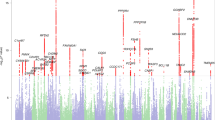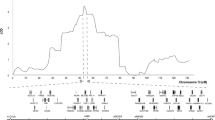Abstract
We describe a family-based sample of individuals with reading disability collected as part of a quantitative trait loci (QTL) mapping study. Eighty-nine nuclear families (135 independent sib-pairs) were identified through a single proband using a traditional discrepancy score of predicted/actual reading ability and a known family history. Eight correlated psychometric measures were administered to each sibling, including single word reading, spelling, similarities, matrices, spoonerisms, nonword and irregular word reading, and a pseudohomophone test. Summary statistics for each measure showed a reduced mean for the probands compared to the co-sibs, which in turn was lower than that of the population. This partial co-sib regression back to the mean indicates that the measures are influenced by familial factors and therefore, may be suitable for a mapping study. The variance of each of the measures remained largely unaffected, which is reassuring for the application of a QTL approach. Multivariate genetic analysis carried out to explore the relationship between the measures identified a common factor between the reading measures that accounted for 54% of the variance. Finally the familiality estimates (range 0.32–0.73) obtained for the reading measures including the common factor (0.68) supported their heritability. These findings demonstrate the viability of this sample for QTL mapping, and will assist in the interpretation of any subsequent linkage findings in an ongoing genome scan.
Similar content being viewed by others
REFERENCES
Ackerman, P. T., and Dykman, R. A. (1993). Gender and reading disability. J.Learn.Disabl. 26: 498.
Brown, B. S. (1978). In: Benton, A. L., and Pearl, D. (eds.), Dyslexia: an appraisal of current knowledge, Oxford University Press, Oxford, pp. v-vii.
Cardon, L. R., Smith, S. D., Fulker, D. W., Kimberling, W. J., Pennington, B. F., and DeFries, J. C. (1994). Quantitative trait locus for reading disability on chromosome 6. Science 266: 276–279. (1995). Quantitative trait locus for reading disability: correction. Science 268: 1553.
Castles, A., Datta, H., Gayan, J., and Olson, R. (1999). Varieties of developmental reading disorder: Genetic and environmental influences. J.of Experimental Child Psychol. 72: 73–94
Castles, A., and Coltheart, M. (1993). Varieties of developmental dyslexia. Cognition 47: 149–180.
Coltheart, M., and Leahy, J. (1996). Assessment of lexical and nonlexical reading abilities in children: some normative data. Aust.J.Psychol. 48: 136–140.
Coltheart, M. (1978). Lexical access in simple reading tasks. In G. Underwood. (ed.), Strategies of information processing. (pp. 151–216). London: Academic Press.
Critchley, M., and Critchley, E. (1978). Dyslexia defined. London: Heinemann Medical Books.
DeFries, J. C., and Álarcon, M. (1996). Genetics of specific reading disability. Ment.Retard.Dev.Disabilities.Res.Rev. 2: 39–47.
Elliot, C. D., Murray, D. J., and Pearson, L. S. (1979). British Abilities Scales (NFER-Nelson, Windsor, UK).
Elliot, C. D., Murray, D. J., and Pearson, L. S. (1983). British Abilities Scales (NFER-Nelson, Windsor, UK).
Ehri, L. C. (1989). The development of spelling knowledge and its role in reading acquisition and reading disability. J.of Learn.Disabil. 22: 356–365.
Ehri, L. C. (1992). Reconceptualizing the development of sight word reading and its relationship to recoding. In P. Gough, L. Ehri, and R. Treiman (eds.), Reading Acquisition (pp. 107–144) Hillsdale, NJ Erlbaum.
Fagerheim, T., Raeymaekers, P., Tonnessen, F. E., Pedersen, M., Tranebjaerg, L., and Lubs, H. A. (1999). A new gene (DYX3) for dyslexia is located on chromosome 2. J.Med.Genet. 36: 664–669.
Feldman, E., Levin, B. E., Fleischmann, J., Jallard, B., Kushch, A., Gross-Glen, K., Rabin, M., and Lubs, H. A. (1995). Gender differences in the severity of adult familial dyslexia. Reading and Writing 7: 155–161.
Field, L. L., and Kaplan, B. J. (1998). Absence of linkage of phonological coding dyslexia to chromosome 6p23-p21.3 in a large family data set. Am.J.Hum.Genet. 63: 1448–1456.
Finucci, J. M., and Childs, B. (1981). Are there really more dyslexic boys than girls? In Ansara, A., Geschwind, N., Galaburda, A., et al. (eds.), Sex differences in dyslexia. Towson MD: Orton Dyslexia Society, pp. 1–9.
Finucci, J. M., Isaacs, S. D., Whitehouse, C. C., and Childs, B. (1983). Classification of spelling errors and their relationship to reading ability, sex, grade placement, and intelligence. Brain.Lang. 20: 340–355.
Fisher, S. E., Marlow, A. J., Lamb, J., Maestrini, E., Williams, D. F., Richardson, A. J., Weeks, D. E., Stein, J. F., and Monaco, A. P. (1999). A quantitative-trait locus on chromosome 6p influences different aspects of developmental dyslexia. Am.J.Hum.Genet. 64: 146–156.
Frederickson, N. (ed.) (1995). Phonological assessment battery. London: Educational Psychology Publishing.
Gallagher, A., and Frederickson, N. (1995). The phonological assessment battery (PhAB): an initial assessment of its theoretical and practical utility. Educ.Child.Psychol. 12: 53–67.
Gayán, J., Smith, S. D., Cherny, S. S., Cardon, L. R., Fulker, D. W., Brower, A. M., Olson, R. K., Pennington, B. F., and DeFries, J. C. (1999). Quantitative-trait locus for specific language and reading deficits on chromosome 6p. Am.J.Hum.Genet. 64: 157–164.
Grigorenko, E. L., Wood, F. B., Meyer, M. S., Hart, L. A., Speed, W. C., Shuster, A., and Pauls, D. L. (1997). Susceptibility loci for distinct components of developmental dyslexia on chromosomes 6 and 15. Am.J.Hum.Genet. 60: 27–39.
Grigorenko, E. L., Wood, F. B., Meyer, M. S., Pauls, D. L. (2000). Report: Chromosome 6p influences on different dyslexia-related cognitive processes: Further confirmation. Am.J.Hum.Genet. 66: 715–723.
Gross-Glenn, K., Skottun, B. C., Glenn, W., Kush, A., Lingua, R., Dunbar, M., Jallard, B., Lubs, H. A., Levin, B., Rabin, M., Parke, L. A., and Duara, R. (1995). Contrast sensitivity in dyslexia. Vis.Neurosci. 12: 153–163.
Guerin, D. W., Griffin, J. R., Gottfried, A. W., and Christenson, G. N. (1993). Dyslexic subtypes and severity levels: Are there gender differences. Optometry Vis.Science 70: 348–351.
Hallgren, B. (1950). Specific dyslexia (congential word blindness): a clinical and genetic study. Acta.Psychiatr.Neurol. 65: 2–289.
Hasstedt, S. (1994). Pedigree Analysis Package. Department of Human Genetics, University of Utah, Slat Lake City, Utah, U.S.A.
James, W. H. (1992). The sex ratios of dyslexic children and their sibs. Dev.Med.Child.Neurol. 34: 530–533.
Jastak, S., Wilkson, G. (1984). Wide-range achievement test (revised): Jastak Associates, Wilmington, DE.
Lambe, E. K. (1999). Dyslexia, gender, and brain imaging. Neuropsych. 37: 521–536.
Lewitter, F. I., DeFries, J. C., and Elston, R. C. (1980). Genetic models of reading disabilities. Behav.Genet. 10: 9–30.
Lubs, H. A., Rabin, M., Feldman, E., Jallard, B. J., Kushch, A., Gross-Glenn, K., Duara, R., et al. (1993). Familial dyslexia: genetic and medical findings in eleven three-generation families. Ann.Dyslexia. 43: 44–60.
Manis, F., Seidenberg, M., Doi, L., McBride-Chang, C., and Petersen, A. (1996). On the basis of two subtypes of developmental dyslexia. Cognition 58: 157–195.
Morton, J. (1969). The interaction of information in word recognition. Psych.Review. 76: 165–178.
Olson, R. K., Wise, B., Conners, F., Rack, J., and Fulker, D. (1989). Specific deficits in component reading and language skills: Genetic and environmental influences. J.of Learn.Disabil. 22: 339–348.
Olson, R., Forsberg, H., Wise, B., and Rack, J. (1994). in Frames of reference for the assessment of learning disabilities: New views on measurement issues, ed. G. R. Lyon (Paul H Brookes, Baltimore), pp. 243–277.
Olson, R., Forsberg, H., and Wise, B. (1994). in The varieties of orthographic knowledge 1: Theoretical and development issues, ed. V. Berninger, (Kluwer Academic, Dordrecht, The Netherlands), pp. 27–71).
Pennington, B. F., Gilger, J. W., Pauls, D., Smith, S. A., Smith, S. D., and DeFries, J. C. (1991). Evidence for major gene transmission of developmental dyslexia. JAMA 266: 1527–1534.
Petryshen, T. L., Kaplan, B. J., Liu, M. F., and Field, L. L. (2000). Report. Absence of significant linkage between phonological coding dyslexia and chromosome 6p23–21.3, as determined by use of quantitative-trait methods: confirmation of qualitative analyses. Am.J.Hum.Genet. 66: 708–714.
Plomin, R., Owen, M. J., and McGuffin, P. (1994). The genetic basis of complex human behaviors. Science 264: 1733–1739.
Rack, J. P., Snowling, M. J., and Olson, R. K. (1992). The nonword reading deficit in developmental dyslexia: a review. Reading Research Quarterly 27: 29–53.
Rutter, M., and Yule, W. (1975). The concept of specific reading retardation. J.Child Psychol.Psychiatry 16: 181–197.
Seidenberg, M., and McClelland, J. (1989). A distributed, developmental model of word recognition and naming. Psychological Review 96: 523–568.
Shaywitz, S. E., Shaywitz, B. A., Fletcher, J. M., and Escobar, M. D. (1990). Prevalence of reading disability in boys and girls. JAMA 264: 998–1002.
Siegel, L. S., and Himel, N. (1998). Socioeconomic status, age and the classication of dyslexic and poor readers: the dangers of using IQ scores in the definition of reading disability. Dyslexia 4: 90–104.
Siegel, L. (1992). An evaluation of the discrepancy definition of dyslexia. Journal of Learning Disabilities 25: 619–629.
Smith, S. D., Kimberling, W. J., Pennington, B. F., and Lubs, H. A. (1983). Specific reading disability: identification of an inherited form through linkage analysis. Science 219: 1345.
Smith, S. D., Gilger, J. W., and Penninton, B. F. (1996). Dyslexia and other specific learning disorders. In: Riomoin, D. L., Connor, J. M., Pyeritx, R. E. (eds.), Principles and Practice of Medical Genetics, Churchill Livingston, New York. pp. 1767–1789.
Stevenson, J. (1991). Which aspects of processing text mediate genetic effects? Reading and Writing: An Interdisciplinary Journal 3: 249–269.
Talcott, J. B., Hebb, G. S., Stoodley, C. J., Westwood, E. A., Witton, C., and Stein, J. F. (2000). Do orthographic and phonological processes explain independent variance in children's literacy skills? Manuscript in preparation.
Thomas, C. J. (1905). Congential “word-blindness” and its treatment. Ophthalmoscope. 3: 380–385.
Thompson, M. E. (1982). The assessment of children with specific reading disabilities (dyslexia) using the British ability scales. Br.J.Psychol. 73: 461–478.
Van Ijzendoorn, M., and Bus, A. (1994). Meta-analytic confirmation of the nonword reading deficit in developmental dyslexia. Reading Research Quarterly 29: 267–275.
Van Orden, G. (1987). A ROWS is a ROSE: Spelling, sound, and reading. Memory and Cognition 15: 181–198.
Vogel, S. A. (1990). Gender differences in intelligence, language, visual-motor disabilities, and academic achievement in students with learning disabilities: a review of the literature. J.Learn.Disab. 23: 44–52.
Wagner, R., and Torgeson, J., (1987). The nature of phonological processing and it's causal role in the acquisition of reading skills. Psycho.Bulletin 101: 92–212.
Wechsler, D. (1981). Wechsler adult intelligence scales (revised). Psychological Corp., Harcourt Brace Jovanovich, San Antio, TX.
Author information
Authors and Affiliations
Rights and permissions
About this article
Cite this article
Marlow, A.J., Fisher, S.E., Richardson, A.J. et al. Investigation of Quantitative Measures Related to Reading Disability in a Large Sample of Sib-Pairs from the UK. Behav Genet 31, 219–230 (2001). https://doi.org/10.1023/A:1010209629021
Issue Date:
DOI: https://doi.org/10.1023/A:1010209629021




